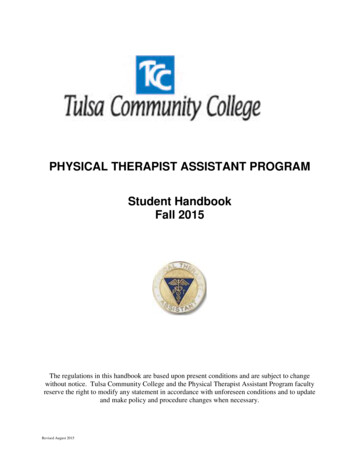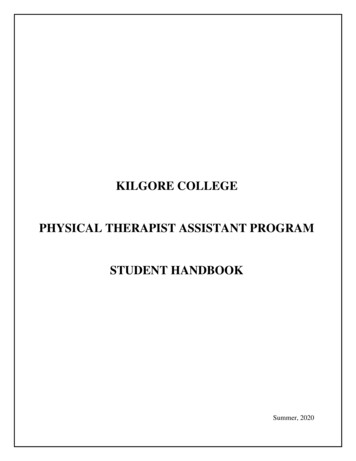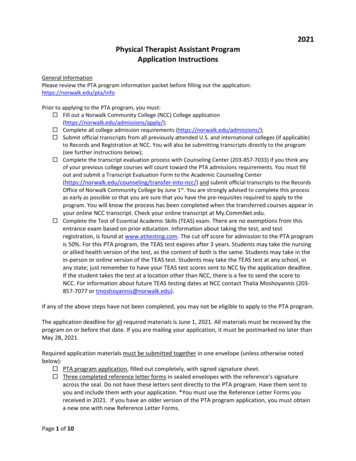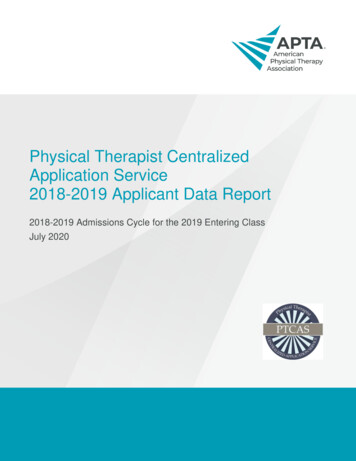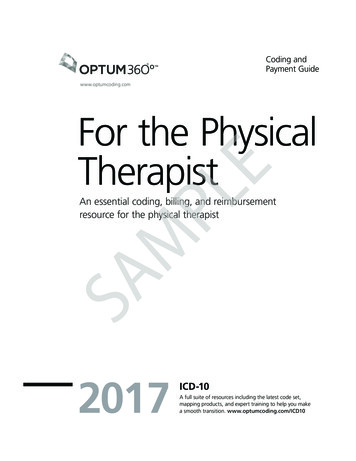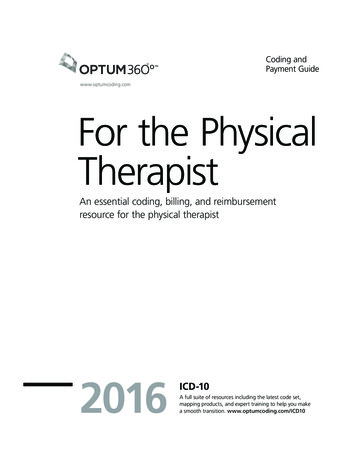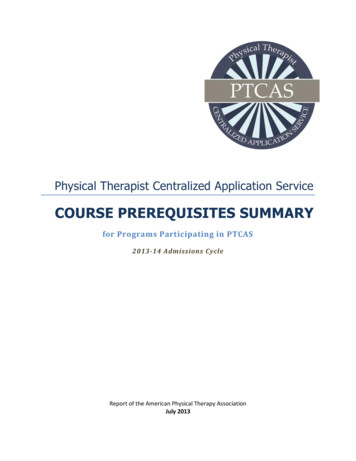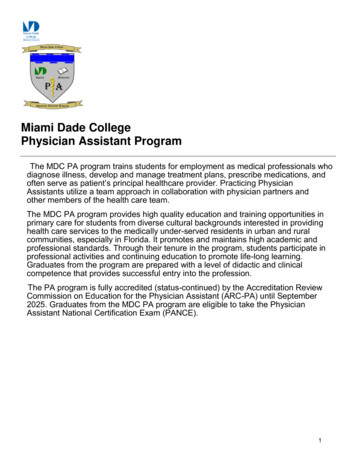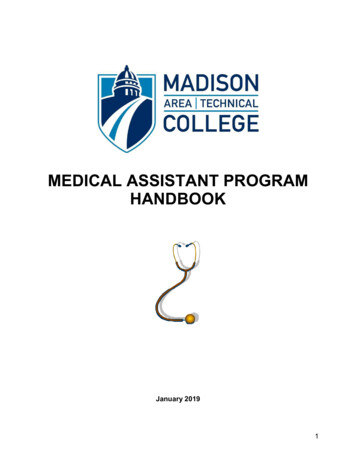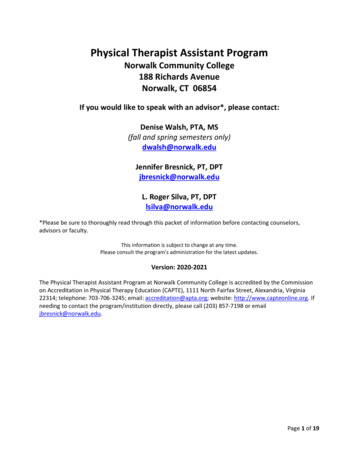
Transcription
Physical Therapist Assistant ProgramNorwalk Community College188 Richards AvenueNorwalk, CT 06854If you would like to speak with an advisor*, please contact:Denise Walsh, PTA, MS(fall and spring semesters only)dwalsh@norwalk.eduJennifer Bresnick, PT, DPTjbresnick@norwalk.eduL. Roger Silva, PT, DPTlsilva@norwalk.edu*Please be sure to thoroughly read through this packet of information before contacting counselors,advisors or faculty.This information is subject to change at any time.Please consult the program’s administration for the latest updates.Version: 2020‐2021The Physical Therapist Assistant Program at Norwalk Community College is accredited by the Commissionon Accreditation in Physical Therapy Education (CAPTE), 1111 North Fairfax Street, Alexandria, Virginia22314; telephone: 703‐706‐3245; email: accreditation@apta.org; website: http://www.capteonline.org. Ifneeding to contact the program/institution directly, please call (203) 857‐7198 or emailjbresnick@norwalk.edu.Page 1 of 19
Check List for PTA Program ApplicationBEFORE you apply to the PTA program:1. Fill out NCC application. Obtain from the Admissions Office or online. Applying will provide youwith a Banner ID (student number) for NCC. You may not use the same ID number from a differentCT community college. Log on and access your account on My.CommNet.edu to verify youradmission to the college, view your college email account and unofficial NCC transcript, etc. Be sureto follow all instructions from the Admissions Office about having your high school diploma andrequired immunizations on file. Students without these documents on file will not be able tochange their major to PTA and register for PTA courses, if admitted to the program.2. Have transcripts evaluated by the Academic Counseling Center (203‐857‐7033) if you think any ofyour previous college courses will count toward the PTA degree. The PTA staff/faculty cannot makethe determination about whether courses from other schools will transfer. Only the AcademicCounseling Center can do this. We can better serve you if you complete this step first (i.e., we can’ttell you which courses to take until we know which courses you have).This process is not automatically triggered by sending one’s transcripts to NCC. Students must fillout a Transcript Evaluation Form online, which is sent to the Academic Counseling nto‐ncc/#transcriptEvaluation). The deadline to fill outand submit the Transcript Evaluation Form along with providing your official transcripts to theRecords Office is June 1st of the year you plan to apply to the program, although it is preferable tocomplete this step as early as possible. You will know the process has been completed when thetransferred courses appear in your online NCC transcript. Check your online transcript atMy.CommNet.edu. Please contact Carolyn Thomas (cthomas@norwalk.edu) with any questionsabout this process.3. Complete Math requirement Placement test results recommending MAT 172 or higher. If you place in at adevelopmental Math level, you must complete the developmental courses prior to applyingto the program. The NCC website has information about the placement exams:https://norwalk.edu/placement‐testing/OR Transfer in Math credits from another school (see #2 above)OR Otherwise be eligible to take MAT 172 or higher (i.e., SAT scores; see admissions office fordetails)4. Complete English requirement Placement test results recommending ENG 101 or higher. If you place in at adevelopmental English level, you must complete the developmental courses prior toapplying to the program. The NCC website has information about the placement exams:https://norwalk.edu/placement‐testing/OR Transfer in English credits from another school (see #2 above)OR Otherwise be eligible to take ENG 101 or higher (i.e., SAT scores; see admissions office fordetails)Page 2 of 19
5. Complete Anatomy & Physiology I (BIO 211 or equivalent) requirement Complete prerequisite for BIO 211 at NCC, which is eligibility for ENG 101; BIO 105 (C orhigher) and/or CHE 111 (C or higher) and/or successful completion (B or higher) of highschool Chemistry within the last two years; or a passing grade on a Biology or Chemistrychallenge exam; or permission of the Science department head (Michele Barber:mbarber@norwalk.edu or (203) 857‐7275). Other schools may have different prerequisitesfor Anatomy and Physiology.AND Complete BIO 211 and earn a C or better at NCC within 5 years of program entry. You mayapply to the PTA program while enrolled in BIO 211 in the spring semester; however,admission to the program is contingent on proof of an appropriate grade.OR Take Anatomy & Physiology I with lab (BIO 211 or equivalent) and earn a C or better(within 5 years of program application) at another school and follow their prerequisites.Remember: the PTA faculty cannot make the determination about whether courses fromother schools will transfer. Only the Academic Counseling Center can do this. If you want toknow whether an A&P course from another school will transfer to NCC, you must contactthe Academic Counseling Center (see #2 above).6. Complete physical therapy observation requirement Arrange your own volunteer, observation, or paid hours with a physical therapy clinic,hospital or skilled nursing facility that provides physical therapy services. For more details,please see “Observation Hours” under the “Explanation of Points Categories” in the“Admissions Policies and Procedures” section in this document.7. Complete the TEAS admissions test prior to applying. There are no exemptions from this entranceexam based on prior education. Information about taking the test, and test registration, is found atwww.atitesting.com. The cut off score for admission to the PTA program is 50%. For this PTAprogram, the TEAS test expires after 3 years. Students may take the nursing or allied health versionof the test, as the content of both is the same. Students may take in the in‐person or online versionof the TEAS test. Students may take the TEAS test at any school, in any state; just remember tohave your TEAS test scores sent to NCC. If the student takes the test at a location other than NCC,there is a fee to send the score to NCC. For information about future TEAS testing dates at NCCcontact Thalia Moshoyannis (203‐857‐7077 or tmoshoyannis@norwalk.edu).8. Complete PTA program application. Applications will be available on February 1st (or the firstbusiness day thereafter) each year (https://norwalk.edu/pta/app). Submission of a completed PTAprogram application is required by June 1st (or the first business day thereafter) each year foradmission in the fall semester. We do not accept late applications. Note: PTA students start in thefall semester only, as the first semester courses are only offered in the fall.Page 3 of 19
Frequently Asked QuestionsWhat is a Physical Therapist Assistant?Physical therapist assistants (PTAs) provide physical therapy services under the direction and supervision ofa physical therapist. PTAs help people of all ages who have medical problems, or other health‐relatedconditions that limit their ability to move and perform functional activities in their daily lives. Care providedby a PTA may include teaching patients/clients exercise for mobility, strength and coordination, training foractivities such as walking with crutches, canes, or walkers, manual therapy, and the use of physical agentsand electrotherapy such as ultrasound and electrical stimulation.What do Physical Therapist Assistants Earn?The national median income for a physical therapist assistant is 57,430 depending on position, years ofexperience, degree of education, geographic location, and practice setting. In Fairfield County, PTAs earn amedian salary of 62,642 according to salary.com (accessed: 8/7/2019).Where do Physical Therapist Assistants work?Today, PTAs provide health care services to patients of all ages and health conditions in a variety ofsettings, including: Outpatient clinics or offices Education or research centers Hospitals and inpatient rehabilitation Industrial, workplace, or otherfacilitiesoccupational environments Skilled nursing, extended care, or subacute Fitness centers and sports trainingfacilitiesfacilities Homes, schools and hospicesWhat are the licensure requirements for becoming a PTA?All 50 states (plus the District of Columbia and U.S. Territories) require PTAs to be licensed, registered, orcertified. The state of Connecticut requires PTAs to be licensed after graduating from an accredited PTAprogram (such as the one at NCC) and passing the national exam (www.fsbpt.org). Check with the state youplan to work in to find out specific requirements.What is the employment outlook for Physical Therapy?According to the Bureau of Labor and Statistics, PTAs are one of the top ten fastest growing occupations.Employment of physical therapist assistants is expected to grow “much faster than the average” for alloccupations through the year 2026.What type of degree will I receive?Upon completion of the program, graduates receive an Associate of Science in Physical Therapist Assistant.Earning that degree makes you eligible to sit for the national licensure exam (www.fsbpt.org).Is this a part‐time or full‐time program?Although it is preferable to complete the program in a two‐year span, it is sometimes difficult to fit a full‐time class schedule into an already busy life. You may choose to complete all general educationrequirements on a part‐time basis in the first two years and then progress part‐time through the technicaleducation (PTA) classes the next four semesters, for a total of four years (keep in mind the final semesterconsists of full‐time internships). Once a student begins the technical education portion of the curriculum(PTA courses), he or she has three years to complete the two‐year program.Page 4 of 19
What is the difference between a PTA and a physical therapist (PT)?To become a PT, in general you must earn a bachelor’s degree, and a Doctor of Physical Therapy from anaccredited institution. PTs perform patient/client examinations and evaluations, which leads to a diagnosis,prognosis and plan of care. The PTA follows the plan of care working under the direction and supervision ofa PT. Certain clinical skills are considered “PT‐only.” Courses from an associate level PTA degree do nottypically transfer to a graduate level PT program, however, general education courses, such as math andEnglish will count toward the bachelor’s degree required for admission to a PT program. For moreinformation please visit the website of the American Physical Therapy Association: www.APTA.org.I want to become a PT, not a PTA. Can you help?If you wish to become a PT, the best way to proceed is to research PT programs and determine therequirements for those programs. CAPTE has a list of accredited PT and PTA programs(www.capteonline.org). Contact the programs you wish to attend if you have questions about how toapply, or what courses to take. While the NCC PTA staff/faculty can provide general advising about a careerin physical therapy, we are unable to provide detailed advice about specific courses required for PTprograms outside of NCC.What is the difference between a physical therapist assistant (PTA) and a physical therapy aide?To become a PTA, one must graduate from a CAPTE accredited program, pass a national exam and obtain alicense from the state in which one wishes to work. A physical therapy aide is an unlicensed professionalwho may assist a PT or PTA in providing physical therapy care, but is never, by law, the provider of thatcare. NCC has a PTA degree program and physical therapy aide certificate course. If you are interested inthe degree program, this packet provides that information. Please contact the department of ContinuingEducation for more information about the physical therapy aide certificate course:https://norwalk.edu/extended‐studies/Can I transfer my PTA credits to a PT program?PTA credits are earned at the undergraduate level. PT credits are earned at the graduate level. Generally,undergraduate credits do not count toward a graduate degree. PTA credits (Math, English, electives) maycount toward undergraduate credits that lead to a bachelor’s degree, which is required for entrance into aDoctor of Physical Therapy program.How much does the program cost?Information about tuition and fees can be found on the NCC ‐fees/. The cost of the entire program (if the student takes allcourses listed in the PTA program curriculum) is approximately 15,500 for an in‐state student. Thisamount is just an estimate. Students should verify tuition and fees with the Business Office. If you havecompleted some of the general education courses required for graduation from the PTA program, the costwill be lower. Financial aid may be available. Please contact the Financial Aid Office for details:https://norwalk.edu/finaid/Page 5 of 19
Admissions Policies and ProceduresImportant DatesAdmissions decisions are made on the following annual cycle (if any of the dates fall on a weekend/holiday,the following business day is used):Program application availableFebruary 1Program application dueJune 1Students notified of admissions decisionsJuly 15Student acceptance requiredJuly 31Wait list candidates informedAugust 1Wait list candidate acceptance requiredAugust 7Orientation3rd Tuesday of AugustEnrollment beginsFall semesterAdmissions Point SystemAll PTA program applicants are ranked according to the admissions point system. The point system is asfollows:CategoryProfessionalismEndorsement fromthe CommunityRequirementApplicant filled out applicationcompletely and correctly, andapplicant submitted all requiredapplication documents on time.Three letter of recommendationformsAcademic AbilityTEAS exam (50% minimum score)Overall GPA (minimum: 2.5)CommunityServiceInsight intoProfessionTotal PointsBIO 211 (Anatomy & Physiology Igrade)Community service activitiesVolunteer or paid experience inphysical therapy environment 0 points if less than 40 hoursdocumented 80 points for minimum of 40hours documentedPoints 25 points if requirement met 0 points if requirement not metAverage score from 3 referenceletter forms (maximum of 28points)% score on exam multiplied by 1.5(Maximum score is 150)Quality points (2.8, e.g.) multipliedby 25 (Maximum of 100)Quality points (2.5, e.g.) multipliedby 25 (Maximum of 100)Maximum of 40 pointsMaximum of 80 pointsTotal: 523This is a competitive admissions program. Not all who apply will be offered admission. Typically, morestudents apply than the program has spots. The students with the top scores will be offered enrollmentinto the PTA program. In the event of a tie, the PTA program advisory board will be given the candidates’information excluding their names and hold a vote to break the tie. The remaining candidates will be placedon a waiting list in ranked order. If accepted candidates decide not to enroll in the program, thencandidates on the waiting list are notified of the opening starting with the highest ranked candidate.Page 6 of 19
Explanation of Points CategoriesLetter of Recommendation Forms The student does not need to submit letters of recommendation. Only the reference forms arenecessary. Three of these forms are found in your application materials (norwalk.edu/pta/app).Students submitting additional letters of recommendation in addition to the forms will receive noadditional points. Recommendations or endorsements (beyond the Recommendation Letter Forms included with theapplication) carry no weight in the application process. It is strongly advised that applicants refrainfrom requesting that individuals (whether they are former students of the program, currentcolleagues in the physical therapy profession, etc.) contact the program administrators to endorsethe candidate (i.e., “put in a good word”). Admissions decisions are based strictly on the pointsystem outlined in this document. Possible sources for Reference Letter Forms may include past or present professors, supervisors ormanagers and/or a representative from a community service experience. At least one reference must be from a credible source in the physical therapy profession. One ofthe reference letter forms included in your application materials is labeled as the “Physical TherapyReference Letter” form. The other two references must come from a professional or scholasticsource, such as an employer or faculty member. References from family members or friends arenot acceptable and will add no points to the applicant’s score. Your own personal PT or PTA (or that of a family member) may not serve as a reference, as thisperson has the ability to evaluate you as a patient or caregiver, but not in the capacity of apotential fellow physical therapy professional. Additionally, a PT or PTA providing a reference for apatient (or patient’s caregiver) can present an ethical dilemma, for example, forcing the PT/PTA tochoose between providing accurate information on the form, and maintaining good rapport with apatient. The applicant is responsible for ensuring that letters of reference arrive by the application deadline.It is suggested that you provide the person providing the reference with a self‐addressed stampedenvelope for him or her to return the reference form to you. All three Reference Forms must besubmitted with your application. Each of the seven areas the individual providing the reference will comment on are assigned pointsas per the table below. The seven areas are:o intellectual abilityo communication/listening skillso critical thinking skillso initiative/motivationo moral/ethical behavioro professionalismo compassion/caring Keep in mind that you receive 0 points if the individual providing the reference has “no basis” forjudging you in a particular category. It is therefore highly recommended that you ask individuals forreferences only if they feel comfortable commenting on all of the areas listed on the form.RatingNo basisBelow averageAverageAbove averageSuperiorPoints01234Page 7 of 19
Observation HoursComplete a minimum of forty (40) hours of documented volunteer/observation or paid experience in aphysical therapy setting. The purpose of this requirement is to provide the student with insight from theperspective of the physical therapist or physical therapist assistant. You must directly observe, or workwith, a physical therapist or physical therapist assistant. Hours spent in observation, internships or workingin a different environment, such as athletic training, chiropractic or exercise science, will not be counted.You many not include hours in which you attended physical therapy yourself, or went with anotherindividual receiving physical therapy, as this provides insight from the perspective of the patient and notthe therapist. Patients/caregivers do not have access to the full experience of being a PT or PTA, including,but not limited to, billing, documentation, professional collaboration with other healthcare providers,managing a patient caseload, and a variety of patients, diagnoses and treatments.Applicants are encouraged to exceed forty (40) hours, and spend time in more than one type of facility tofurther their understanding of a career in physical therapy and receive the maximum number of points onthe application. Applicants should keep track of these hours and will be required to submit writtendocumentation at the time of application, in the form of a letter(s) on letterhead from the facility/facilitieswhere the hours where completed.The program does not provide a list of, or find, facilities for applicants to complete their observation hours.Students should identify a facility that offers physical therapy services, and make an inquiry to the facility.TEAS ExamThe Test of Essential Academic Skills (T
www.atitesting.com. The cut off score for admission to the PTA program is 50%. For this PTA program, the TEAS test expires after 3 years. Students may take the nursing or allied health version of the test, as the content of both is the s

